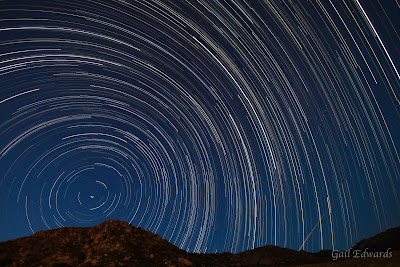
My main recourse for showing off my photos is Flickr. For the most part, it it the only place where I receive feedback and well, I receive praise for my work! WHO does not love that? But once in a while I get questions and once in a while, I missed the chance to answer that question! What is it that I am asked the most about? My star trails! The one question that was asked and I never got a chance to ask, because it was deleted or I just cannot find it, why do I stack my star trails and not take one long one?
The image above is 3.5 hours worth of exposures. Each and every exposure being 30 seconds long and then I stack them together to make one image. Now, imagine if I would have taken a single exposure even half that amount of time! Not only is it tough to post process to make it look like a night time image, but that would be if it was not totally washed out! :) SO, thats why. Why 30 seconds for the stacking time? Because my camera only goes to 30 seconds with out help and I am not willing to sit by my camera for 3+ hours to turn on and off the shutter every 2 to 5 minutes! However, I am working on getting some new gear for my bag that will do that for me! Stay tuned for the new timer remote! (Soon, I hope)
The next thing I hear all the time, "Such a long process, so much involved!" Yes, there are many steps involved! But each and every one is easy! And if you are stacking, you defiantly can play around with ISO, if your camera can handle it, go for ISO 500! Or higher. But ISO 400 is quite comfortable for just about any camera.
1) Go wide! Wide aperture and wide lens. F/3.5 or F/4 is great! But makes a difference, so the best way to know what works for you is to play around. Set your camera for a 30 second exposure then change the aperture for another 30 second exposure to see what you get! Time is what is needed to make it perfect for you! It took me months of doing star trails before I realized I love to keep it at f/3.5. And the wide lens, when you are doing star trails, the more wide, the less gaps between images. Gaps happen. But going wide will make a huge difference. My choice of lens is my Tamron 10-24mm. And I set to 10mm.
2) Set your camera to Continuous shooting mode which will keep your camera shooting when you walk away. That with the help of a shutter lock. Which is a cable that locks the exposure so that, once again, when you walk away, the camera keeps clicking.
3) Set your camera up to your composition, take a few test shots and make sure that your settings are going to work for how dark it is. A full moon will make a difference on the final outcome!
4) jPeg VS. RAW! Well, any one who is any one shoots RAW, right? Well, I am not saying I am any one, but I shot raw! Except for these star trails! Because when you take 300+ images, there is NO chance I am going into all the images to do the extra sharpening that is automatic with jPeg! Now, I have done both ways, but when you do RAW, you need to batch process the images, and make them jPeg to work the stacking software. Well, at least the only software I know! To convert from RAW to jPeg is a LONG but painless process! So shoot which ever way you want to! It will work.
5) Once you have all of your images that you want to stack together, you can stack them together using any of the many programs out there to do the trick. I hear that Photo Shop does stacking, so if you have it, use it! I heard its a little cumbersome, but I have no idea, I have never played with Photo Shop! The software I use is free and easy, however, only useable on PC. Because I am a MAC user, I have to dust off the PC for this. But I do so many star trails now, there is no more dust left!
There is the link for what I use. I sure do hope you take some time to try this your self!
Then, last but not least, a LOT of people tell me, "Oh, I want to try this!" GO FOR IT! Thats what I say. Get out of the city and shoot! Instead of shoot for the stars, go and shoot the stars!
The image above:
421 exposures, 30 seconds each
ISO 400
f/3.5
10mm
OH, and I forgot to say, this was on the evening where we got a 5.7 earthquake that was 54 miles from our home. The shift in the composition is from the quake, so there is not 2 north stars! :)